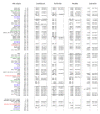A high-resolution map of the Nile tilapia genome: a resource for studying cichlids and other percomorphs
- PMID: 22672252
- PMCID: PMC3441813
- DOI: 10.1186/1471-2164-13-222
A high-resolution map of the Nile tilapia genome: a resource for studying cichlids and other percomorphs
Abstract
Background: The Nile tilapia (Oreochromis niloticus) is the second most farmed fish species worldwide. It is also an important model for studies of fish physiology, particularly because of its broad tolerance to an array of environments. It is a good model to study evolutionary mechanisms in vertebrates, because of its close relationship to haplochromine cichlids, which have undergone rapid speciation in East Africa. The existing genomic resources for Nile tilapia include a genetic map, BAC end sequences and ESTs, but comparative genome analysis and maps of quantitative trait loci (QTL) are still limited.
Results: We have constructed a high-resolution radiation hybrid (RH) panel for the Nile tilapia and genotyped 1358 markers consisting of 850 genes, 82 markers corresponding to BAC end sequences, 154 microsatellites and 272 single nucleotide polymorphisms (SNPs). From these, 1296 markers could be associated in 81 RH groups, while 62 were not linked. The total size of the RH map is 34,084 cR(3500) and 937,310 kb. It covers 88% of the entire genome with an estimated inter-marker distance of 742 Kb. Mapping of microsatellites enabled integration to the genetic map. We have merged LG8 and LG24 into a single linkage group, and confirmed that LG16-LG21 are also merged. The orientation and association of RH groups to each chromosome and LG was confirmed by chromosomal in situ hybridizations (FISH) of 55 BACs. Fifty RH groups were localized on the 22 chromosomes while 31 remained small orphan groups. Synteny relationships were determined between Nile tilapia, stickleback, medaka and pufferfish.
Conclusion: The RH map and associated FISH map provide a valuable gene-ordered resource for gene mapping and QTL studies. All genetic linkage groups with their corresponding RH groups now have a corresponding chromosome which can be identified in the karyotype. Placement of conserved segments indicated that multiple inter-chromosomal rearrangements have occurred between Nile tilapia and the other model fishes. These maps represent a valuable resource for organizing the forthcoming genome sequence of Nile tilapia, and provide a foundation for evolutionary studies of East African cichlid fishes.
Figures






Similar articles
-
Comparative physical maps derived from BAC end sequences of tilapia (Oreochromis niloticus).BMC Genomics. 2010 Nov 16;11:636. doi: 10.1186/1471-2164-11-636. BMC Genomics. 2010. PMID: 21080946 Free PMC article.
-
A microsatellite-based genetic linkage map and putative sex-determining genomic regions in Lake Victoria cichlids.Gene. 2015 Apr 15;560(2):156-64. doi: 10.1016/j.gene.2015.01.057. Epub 2015 Jan 30. Gene. 2015. PMID: 25639358
-
Chromosome-scale assemblies reveal the structural evolution of African cichlid genomes.Gigascience. 2019 Apr 1;8(4):giz030. doi: 10.1093/gigascience/giz030. Gigascience. 2019. PMID: 30942871 Free PMC article.
-
Genome editing in East African cichlids and tilapias: state-of-the-art and future directions.Open Biol. 2023 Nov;13(11):230257. doi: 10.1098/rsob.230257. Epub 2023 Nov 29. Open Biol. 2023. PMID: 38018094 Free PMC article. Review.
-
A genomic glimpse of B chromosomes in cichlids.Genes Genomics. 2021 Mar;43(3):199-208. doi: 10.1007/s13258-021-01049-4. Epub 2021 Feb 6. Genes Genomics. 2021. PMID: 33547625 Review.
Cited by
-
Polygenic sex determination in the cichlid fish Astatotilapia burtoni.BMC Genomics. 2016 Oct 26;17(1):835. doi: 10.1186/s12864-016-3177-1. BMC Genomics. 2016. PMID: 27784286 Free PMC article.
-
Transcriptome Profiling and Analysis of Genes Associated with High Temperature-Induced Masculinization in Sex-Undifferentiated Nile Tilapia Gonad.Mar Biotechnol (NY). 2020 Jun;22(3):367-379. doi: 10.1007/s10126-020-09956-5. Epub 2020 Feb 22. Mar Biotechnol (NY). 2020. PMID: 32088770
-
A Dense Linkage Map of Lake Victoria Cichlids Improved the Pundamilia Genome Assembly and Revealed a Major QTL for Sex-Determination.G3 (Bethesda). 2018 Jul 2;8(7):2411-2420. doi: 10.1534/g3.118.200207. G3 (Bethesda). 2018. PMID: 29760203 Free PMC article.
-
Genetic sex determination in Astatotilapia calliptera, a prototype species for the Lake Malawi cichlid radiation.Naturwissenschaften. 2017 Jun;104(5-6):41. doi: 10.1007/s00114-017-1462-8. Epub 2017 Apr 25. Naturwissenschaften. 2017. PMID: 28444435
-
Draft sequencing and assembly of the genome of the world's largest fish, the whale shark: Rhincodon typus Smith 1828.BMC Genomics. 2017 Jul 14;18(1):532. doi: 10.1186/s12864-017-3926-9. BMC Genomics. 2017. PMID: 28709399 Free PMC article.
References
-
- FAO. The State of World Fisheries and Aquaculture. 2010. http://wwwfaoorg/docrep/013/i1820e/i1820e00htm.
-
- Randall DJ, Wood CM, Perry SF, Bergman H, Maloiy GM, Mommsen TP, Wright PA. Urea excretion as a strategy for survival in a fish living in a very alkaline environment. Nature. 1989;337(6203):165–166. - PubMed
-
- Tine M, de Lorgeril J, D’Cotta H, Pepey E, Bonhomme F, Baroiller JF, Durand JD. Transcriptional responses of the black-chinned tilapia Sarotherodon melanotheron to salinity extremes. Marine Genomics. 2008;1:37–46. - PubMed
-
- Baroiller JF, D'Cotta H, Bezault E, Wessels S, Hoerstgen-Schwark G. Tilapia sex determination: Where temperature and genetics meet. Comparative biochemistry and physiology. 2009;153(1):30–38. - PubMed
-
- Trewavas E. Tilapiine fishes of the genera Sarotherodon. Oreochromis and Danakilia, British Museum Natural History, London, UK; 1983.
Publication types
MeSH terms
LinkOut - more resources
Full Text Sources

